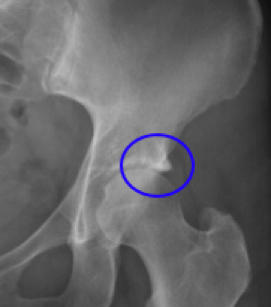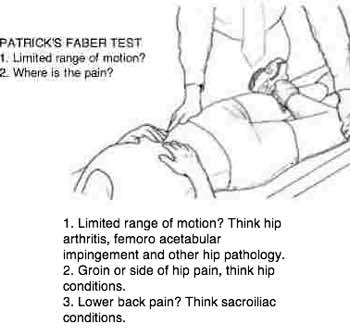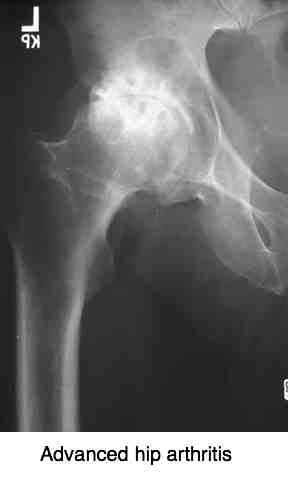Diagnosing the stiff hip

Diagnosing the stiff hip is not difficult with these easy orthopaedic tests. It is not unexpected in the older patient but the young person may not know that he has a condition that will progress to full blown arthritis and total joint replacement if he does not make some changes in his or her lifestyle.
Diagnosing the stiff hip is an imperative in my clinic for every patient of all ages; detected early there is much that chiropractors can do for this silent, progressive disease. So often it is diagnosed too late, and total hip replacement is necessary.
The younger person just usually thinks they are a bit stiff and that it is normal since there is no pain; meantime there could be an impingement syndrome that requires some action.
These tests are not rocket science and you the patient with the help of a partner could do them yourself; interpreting the results of your findings is another matter however.
The young patient
I will never forget the first young patient I examined for groin pain; after the physical examination, I was convinced he had hip arthritis, but how is that possible in a 22-year athlete?
I was an equally young and naive chiropractor; a thorough examination and understanding of the hip joint was not a big part of our training in the seventies. And in fact, the diagnosis of hip impingement was only established much later in any case.
Even today, radiologist will sometimes make no comment on a large pincer or CAM deformity seen on x-ray, or call it arthritis. Such was my own understanding of the hip impingement syndrome forty years ago.
Hip impingement if not diagnosed early leads to progress groin pain, early disability and full blown arthritis; so, what are the tests?
The older patient
Diagnosing the stiff hip in the older patient is essentially the same as for the young person; only it does not come as a surprise when one finds these orthopaedic tests are positive.
Test 1: Supine anatomical position, internal and external rotation
Lay the patient supine in the anatomical position; hips and knees are in the neutral location. The examiner stands at the foot of the bed, grasps the foot and ankle firmly, and turns first the normal leg inwards and then into external rotation; repeat with the naughty limb.
The focus and intention is to rotate the hip, feeling for limited movement and a hard end-feel. Compare the legs for range of motion and the presence of pain in the groin.
I call this the SNIR test; supine, neutral position, internal rotation. And similarly, SNER.
Test 2: Supine, hip flexed and adducted, internal and external rotation
Lay the patient supine with the hip flexed to 90 degrees; adduct the joint across the midline with the knee moving towards the opposite shoulder. Now rotate the hip, moving the foot first away from the body (internal hip rotation) and then towards (external hip rotation).
These tests are often called FAdIR and FAdEr; flexion, adduction and internal or external rotation.
Typically for an anterior impingement, FAdIR is limited and painful in the groin, often with a hard end-feel.
Test 3: Patrick's FAbER test

Lying supine, the hip is brought partially into flexion, the foot is placed on the opposite knee, and the knee is allowed to drop into the lotus position; abduction and external rotation; FAbEr.
Again we are looking for loss of full range of motion, reproducing the pain in a stiff hip, if present, and loss of a soft end-feel.
Always compare sides.
This test is also used along with the POSH position to test for sacroiliac pain.
Diagnosing the stiff hip
Whilst recognising a problem is not difficult, diagnosing the stiff hip requires understanding and experience in examining the joint; and an x-ray.
A retrospective study found that it typically takes examinations by four medical doctors over a period of three years to make the correct diagnosis[1]. I cannot vouch that chiropractors would do any better, but I routinely examine every new patient for hip impingement. It takes no more than one minute to do these three tests.
As has been said so often, if you do not look for it, you will not find it. When missed this may well be the result.

There are two types of impingement; Pincer and CAM deformities. This x-rays reveals the second type. Read more about femoro acetabular impingement syndrome.
Steps in a lifetime
If you live until 80 you will make about 200 million steps[2]. Perhaps the most difficult factor to accept for the patient with the stiff hip, is that his body will only manage a half or three-quarters of that, and that running is inadvisable; certainly longer distances.
Of course you are not just a hip, and the whole body needs to be considered.
- Clinical presentation of patients with symptomatic anterior hip impingement.
- How Far Does the Average Human Walk in a Lifetime?
Did you find this page useful? Then perhaps forward it to a suffering friend. Better still, Tweet or Face Book it.
